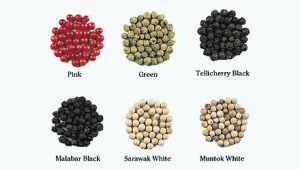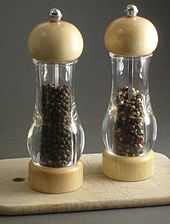Herb and Spice of the Week – Pepper
March 5, 2015 at 6:33 AM | Posted in Herb and Spice of the Week | Leave a commentTags: Black pepper, Cooking, Food, Herb and Spice of the Week, Herbs, Pepper, Pepper Corns, recipes, Salt, Seasonings, Spices, White Pepper
Black pepper (Piper nigrum) is a flowering vine in the family Piperaceae, cultivated for its fruit, which is usually dried and used as a spice and seasoning. The fruit, known as a peppercorn when dried, is approximately 5 millimetres (0.20 in) in diameter, dark red when fully mature, and, like all drupes, contains a single seed. Peppercorns, and the ground pepper derived from them, may be described simply as pepper, or more precisely as black pepper (cooked and dried unripe fruit), green pepper (dried unripe fruit) and white pepper (ripe fruit seeds).
Black pepper is native to south India, and is extensively cultivated there and elsewhere in tropical regions. Currently Vietnam is the world’s largest producer and exporter of pepper, producing 34% of the world’s Piper nigrum crop as of 2008.
Dried ground pepper has been used since antiquity for both its flavour and as a traditional medicine. Black pepper is the world’s most traded spice. It is one of the most common spices added to European cuisine and its descendants. The spiciness of black pepper is due to the chemical piperine, not to be confused with the capsaicin that gives fleshy peppers theirs. It is ubiquitous in the modern world as a seasoning, and is often paired with salt.
Black pepper
Black pepper is produced from the still-green unripe drupes of the pepper plant. The drupes are cooked briefly in hot water, both to clean them and to prepare them for drying. The heat ruptures cell walls in the pepper, speeding the work of browning enzymes during drying. The drupes are dried in the sun or by machine for several days, during which the pepper around the seed shrinks and darkens into a thin, wrinkled black layer. Once dried, the spice is called black peppercorn. On some estates, the berries are separated from the stem by hand and then sun-dried without the boiling process.
Once the peppercorns are dried, pepper spirit & oil can be extracted from the berries by crushing them. Pepper spirit is used in many medicinal and beauty products. Pepper oil is also used as an ayurvedic massage oil and used in certain beauty and herbal treatments.
White pepper
White pepper consists of the seed of the pepper plant alone, with the darker-colored skin of the pepper fruit removed. This is usually accomplished by a process known as retting, where fully ripe red pepper berries are soaked in water for about a week, during which the flesh of the pepper softens and decomposes. Rubbing then removes what remains of the fruit, and the naked seed is dried. Sometimes alternative processes are used for removing the outer pepper from the seed, including removing the outer layer through mechanical, chemical or biological methods.
Ground white pepper is often used in cream sauces, Chinese and Thai cuisine, and dishes like salad, light-colored sauces and mashed potatoes, where black pepper would visibly stand out. White pepper has a slightly different flavor than black pepper, due to the lack of certain compounds present in the outer fruit layer of the drupe, but not found in the seed. A slightly sweet version of white pepper from India is sometimes called Safed Golmirch (Hindi), Shada golmorich (Bengali), or Safed Golmirch (Punjabi).
Green pepper
Green pepper, like black, is made from the unripe drupes. Dried green peppercorns are treated in a way that retains the green color, such as treatment with sulphur dioxide, canning or freeze-drying. Pickled peppercorns, also green, are unripe drupes preserved in brine or vinegar. Fresh, unpreserved green pepper drupes, largely unknown in the West, are used in some Asian cuisines, particularly Thai cuisine. Their flavor has been described as spicy and fresh, with a bright aroma. They decay quickly if not dried or preserved.
Wild pepper
Wild pepper grows in the Western Ghats region of India. Into the 19th Century, the forests contained expansive wild pepper vines, as recorded by the Scottish physician Francis Buchanan, (also a botanist and geographer) in his book, A journey from Madras through the countries of Mysore, Canara and Malabar (Volume III). However, deforestation resulted in wild pepper growing in more limited forest patches from Goa to Kerala, with the wild source gradually decreasing as the quality and yield of the cultivated variety improved. No successful grafting of commercial pepper on wild pepper has been achieved to date.
Orange pepper and red pepper
Orange pepper or red pepper usually consists of ripe red pepper drupes preserved in brine and vinegar. Ripe red peppercorns can also be dried using the same color-preserving techniques used to produce green pepper.
Pink pepper and other plants used as pepper
Pink pepper from Piper nigrum is distinct from the more-common dried “pink peppercorns”, which are actually the fruits of a plant from a different family, the Peruvian pepper tree, Schinus molle, or its relative the Brazilian pepper tree, Schinus terebinthifolius. A pink peppercorn (French: baie rose, “pink berry”) is a dried berry of the shrub Schinus molle, commonly known as the Peruvian peppertree. As they are members of the cashew family, they may cause allergic reactions including anaphylaxis for persons with a tree nut allergy.
The bark of Drimys winteri (“Canelo” or “Winter’s Bark”) is used as a substitute for pepper in cold and temperate regions of Chile and Argentina where it is easily available.
In New Zealand the seeds of Kawakawa (Macropiper excelsum), a relative of black pepper, are sometimes used as pepper and the leaves of Pseudowintera colorata (mountain horopito) are another replacement for pepper.
Several plants in the United States are used also as pepper substitutes, such as Lepidium campestre, Lepidium virginicum, shepherd’s purse, horseradish, and field Pennycress.
Like many eastern spices, pepper was historically both a seasoning and a folk medicine. Long pepper, being stronger, was often the preferred medication, but both were used. Black Pepper (or perhaps long pepper) was believed to cure illness such as constipation, diarrhoea, earache, gangrene, heart disease, hernia, hoarseness, indigestion, insect bites, insomnia, joint pain, liver problems, lung disease, oral abscesses, sunburn, tooth decay, and toothaches. Various sources from the 5th century onward also recommend pepper to treat eye problems, often by applying salves or poultices made with pepper directly to the eye. There is no current medical evidence that any of these treatments has any benefit; pepper applied directly to the eye would be quite uncomfortable and possibly damaging. Nevertheless, black pepper, either powdered or its decoction, is widely used in traditional Indian medicine and as a home remedy for relief from sore throat, throat congestion, cough etc.
Pepper is known to cause sneezing. Some sources say that piperine, a substance present in black pepper, irritates the nostrils, causing the sneezing; Few, if any, controlled studies have been carried out to answer the question.
Piperine is under study for its potential to increase absorption of selenium, vitamin B, beta-carotene and curcumin as well as other nutrients. As a folk medicine, pepper appears in the Buddhist Samaññaphala Sutta, chapter five, as one of the few medicines allowed to be carried by a monk.
Pepper contains phytochemicals, including amides, piperidines, pyrrolidines and trace amounts of safrole which may be carcinogenic in laboratory rodents.
Piperine is under study for a variety of possible physiological effects, although this work is preliminary and mechanisms of activity for piperine in the human body remain unknown.
Pepper gets its spicy heat mostly from piperine derived both from the outer fruit and the seed. Black pepper contains between 4.6% and 9.7% piperine by mass, and white pepper slightly more than that. Refined piperine, by weight, is about one percent as hot as the capsaicin found in chili peppers. The outer fruit layer, left on black pepper, also contains important odour-contributing terpenes including pinene, sabinene, limonene, caryophyllene, and linalool, which give citrusy, woody, and floral notes. These scents are mostly missing in white pepper, which is stripped of the fruit layer. White pepper can gain some different odours (including musty notes) from its longer fermentation stage. The aroma of pepper is attributed to rotundone (3,4,5,6,7,8-Hexahydro-3α,8α-dimethyl-5α-(1-methylethenyl)azulene-1(2H)-one), a sesquiterpene originally discovered in the tubers of cyperus rotundus, which can be detected in concentrations of 0.4 nanograms/L in water and in wine: rotundone is also present in marjoram, oregano, rosemary, basil, thyme, and geranium, as well as in some Shiraz wines.
Pepper loses flavor and aroma through evaporation, so airtight storage helps preserve its spiciness longer. Pepper
can also lose flavor when exposed to light, which can transform piperine into nearly tasteless isochavicine. Once ground, pepper’s aromatics can evaporate quickly; most culinary sources recommend grinding whole peppercorns immediately before use for this reason. Handheld pepper mills or grinders, which mechanically grind or crush whole peppercorns, are used for this, sometimes instead of pepper shakers that dispense pre-ground pepper. Spice mills such as pepper mills were found in European kitchens as early as the 14th century, but the mortar and pestle used earlier for crushing pepper have remained a popular method for centuries as well.
Create a free website or blog at WordPress.com.
Entries and comments feeds.











